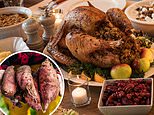Do YOU make your tea correctly? 80% of us are too impatient to brew a proper cuppa, study reveals
- The study was commissioned ahead of British Science Week
- Researchers asked 1,000 people about their tea-drinking habits
- They found English Breakfast made without sugar is the most popular tea
- Only 16% of people let the water brew for the recommended time of between two and five minutes
- And 47% remove the bag but leave their tea to cool for five minutes
- It follows reports from the British Standard Institute that said tea should be steeped for six minutes and the milk should be added first
Three quarters of us drink tea every day but many of us are too impatient to let it steep properly.
Steeping is the act of letting the flavour of the tea infuse into the water, and scientists claim it should be left for a minimum of two minutes.
But a study has found that 80 per cent of tea drinkers can't wait that long - and 40 per cent of us drink it immediately meaning we don't get the best flavour from our cuppa.

Researchers asked 1,000 people about their tea-drinking habits and found that only 16% of people let the water brew, or steep, for the recommended time of between two and five minutes. Nearly half (47 per cent) leave their tea to cool for five minutes after they have removed the tea bag before drinking it
The study was commissioned ahead of British Science Week - a 10-day programme of science, technology, engineering and maths events across the UK that started on 13 March.
Researchers asked 1,000 people about their tea-drinking habits and discovered that English Breakfast made without sugar and drunk from a ceramic mug is the most popular method.
Only 16 per cent of people let the water brew for the recommended time of between two and five minutes. But this time varies depending on the type of tea.
And nearly half (47 per cent) leave their tea to cool for five minutes after they have removed the tea bag before drinking it.
Elsewhere, the age-old debate of water or milk first was found to vary depending on how the tea is being drunk.
If the tea is being made in a cup or mug the milk should be added last, and more than two thirds (69 per cent) of tea drinkers use this technique.
But when made using a tea pot, the milk should be added to the mug before the tea-infused hot water is poured into it.
The study additionally found that the over 65s are more likely to add milk first.
Mark Miodownik, Professor of Materials and Society at University College London said: 'This may be controversial, but the British do not understand how to make tea! Or at least they’re not doing it properly.
'And it’s because they don’t understand the variables. Expediency is causing us to throw chemistry out of the window; we’re not allowing our tea to brew for long enough, to release the flavours properly.'
The decline in use of the teapot is another factor,' Professor Miodownik added: 'What you make tea in, and drink it out of, is also important. It alters the taste.'
These findings follow reports last month that said to make the perfect cup of tea - according to the British Standards Institute guidelines - the milk should be put in the cup first, the pot must be made of porcelain, there must be at least 2g of tea for every 100ml and the water must not exceed 85°C (185°F) when served.
And these guidelines explained that black tea should be steeped for at six minutes.
The BSI is the business standards company best known for the BSI Kitemark.
This mark is an internationally recognised symbol of excellence and is seen on everything from manholes to aircraft.

Elsewhere the experts said that if tea is being made in a cup or mug the milk should be added last, and more than two thirds (69 per cent) of tea drinkers use this technique. But when made using a tea pot, the milk should be added to the mug before the tea-infused hot water is poured into it

To a tea: Experts say many of us Brits are not leaving our tea to steep for long enough
The institution's best practice when it comes to making a cup of tea is called 'Preparation of a liquor of tea for use in sensory tests.'
According to this standard, two different sized pots made of porcelain or glazed earthenware are recommended, alongside two corresponding small and large 'bowls' - or cups.
The first, large pot should measure be between 74mm and 78mm wide and stand between 83mm and 87mm tall. It should also have a lid.
The ideal smaller pot should be between 61mm and 65 mm tall and ideally 64mm wide.
The larger cup is should be between 57mm and 63mm tall by 109mm - plus or minus 3mm -compared to 49mm and 55mm wide.
Either way, the large pot should not exceed 318ml, and the small pot must have a maximum capacity of 159ml.

These findings follow reports last month that said to make the perfect cup of tea - according to the British Standards Institute guidelines - the milk should be put in the cup first, the pot must be made of porcelain, there must be at least 2g of tea for every 100ml and the water must not exceed 85°C (185°F) when served

On average, a teabag weighs 2g but contains around 1.5g of tea leaves so at least two should be used for a small pot and at least four should be used for a larger pot. When being made with milk, the tea should be made and brewed in the same way and then added to at least 2.5ml milk in the bowl
To make tea without milk, 2g of tea should be used for every 100ml of water. Pour freshly boiled water into the pot up to 4mm and 6mm below the brim.
The tea should then be left to infuse for six minutes.

Lyons Tea recently released this tongue-in-cheek colour chart to help friends and family make tea to a person's preferred strength
On average, a teabag weighs 2g but contains around 1.5g of tea leaves, so at least two bags should be used for a small pot of tea and at least four should be used for a larger pot.
When made with milk, the tea should be made and brewed in the same way and then added to milk in the cup.
At least 2.5ml milk is recommended for use with a smaller pot, and 5ml milk is advised for the larger pot.
This helps the milk mix more evenly though the 'liquor' when the tea is added to the bowl.
To make sure the water doesn't scald the milk, the BSI explained that its temperature should not exceed 85°C (185°F), but should be above 60°C (140°F) for optimum flavour and sensation.
The standard does explain that different sized pots can be used, but these measurements are recommended.
If milk is added first and the teabag is dropped into the milk before it has infused with the water, then the steeping process is affected.
It doesn't affect the brewing process, but it will cool down the liquid which will directly impact the effectiveness of the steeping.
Dr. Stanley Segall at Drexel University, Philadelphia said: 'When you steep tea leaves in hot water, water-soluble materials are extracted to produce the tea.
'Changes in brewing temperature affect extraction of colour- and flavour-responsible chemicals exponentially.'
He explained that reaction rates generally double for every rise in temperature of 18°F, and decrease by the same factor when the temperature is lowered.
Most watched News videos
- Scottish woman has temper tantrum at Nashville airport
- Tesla Cybertruck explodes in front of Trump hotel in Las Vegas
- Mass panic as New Orleans attacker flies down Bourbon street
- Shocking moment zookeeper is fatally mauled by lions in private zoo
- Horrific video shows aftermath of New Orleans truck 'attack'
- Meghan Markle celebrates new year in first Instagram video
- Tesla Cybertruck burns outside Trump hotel in Las Vegas
- See how truck that drove into crowd made it through police barrier
- Cheerful Melania Trump bops to YMCA at Mar-a-Lago NYE bash
- New Orleans terror attack suspect reveals background in video
- Plane passenger throws drink at flight attendant in boozy fight
- Horrifying moment yacht crashes into rocks and sinks off Mexico coast





































































































































































































































































